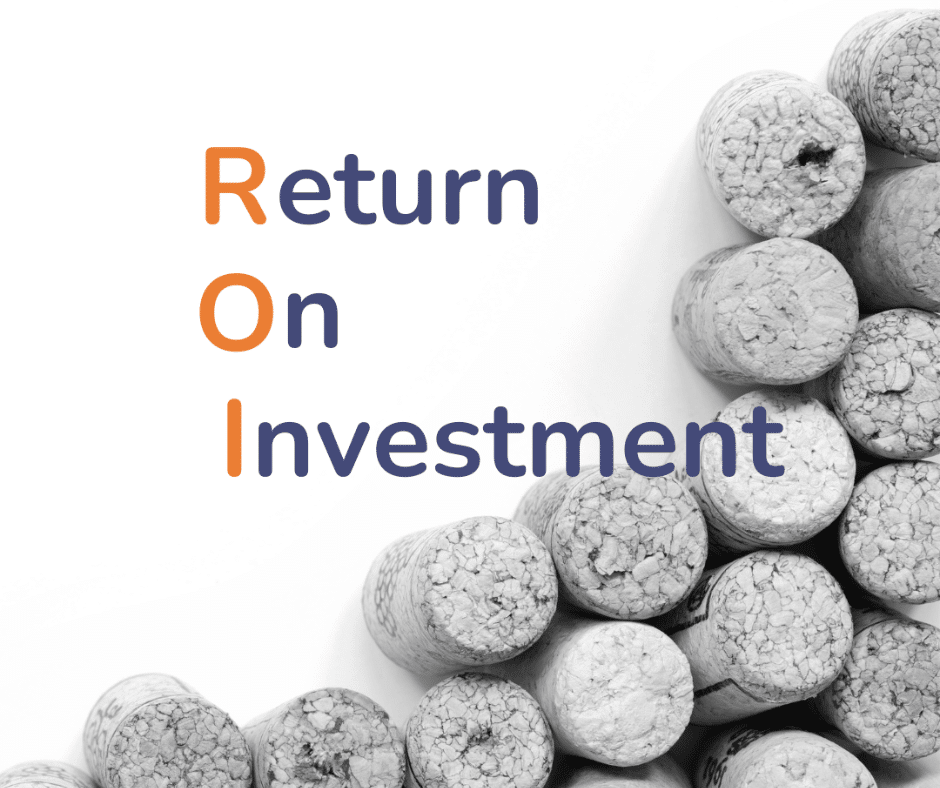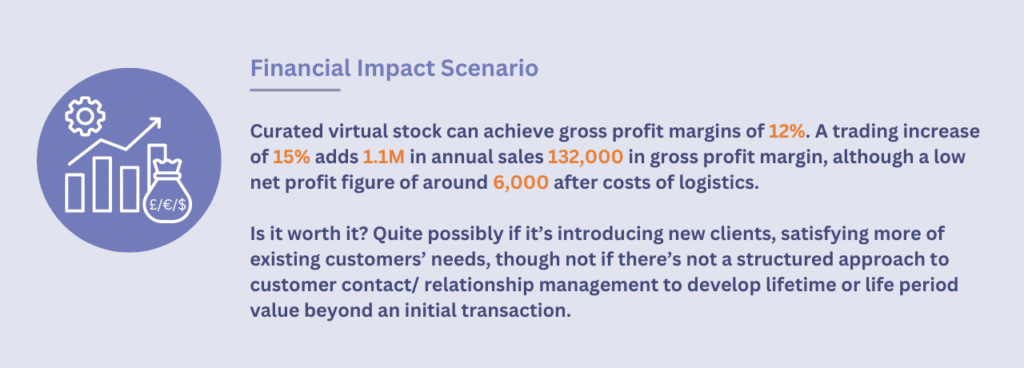Moving off spreadsheets or an outdated, insecure or otherwise not-for-purpose system onto a digital operating platform (a modern equivalent of an ERP) can make business owners think twice.
When considering new wine software, the question is, is it worth it?
What may seem like a daunting commitment due to the costs of implementation and additional monthly fees, in reality, requires assessing what financial and organisational benefits it will bring.
Calculating ROI for a business investment is a bit like that: a number that looks significant may turn out be one of the best decisions you’ve made if it’s going to deliver a bottom line impact quickly.
Put simply, spend five to get back ten.
Conversely, a low cost set-up may actually cost you time and more money if you end up trying to run your business on something that’s not fit for purpose.
Return on investment can be practically estimated by stepping through your various activities that will save costs and make money, using our financial impact scenarios below. Add up those numbers and it becomes pretty clear whether new wine software makes good sense.


Multi-channel and Omni-channel management
Multi-channel (selling through a number of digital channels concurrently) and Omni-channel (selling offline and online concurrently – e.g. bricks and mortar shops, phone, email and eCommerce) needs orchestration by a system of record that can handle orders and depletions in near enough real-time.
Having an accurate and up to date stock position that depletes SKUs, as products sell through one or another sales channel, ensures you don’t oversell nor promote a wine that’s sold out. That reduces cost of customer service and saves the cost of making good (if you are minded to do so).
Being able to offer for sale your entire inventory position through all your chosen channels gives you the best chance of finding buyers, wherever or however they prefer to transact. It’s a path to growth that needs scrupulous management.

Reducing errors
It’s easier than ever to make mistakes. We’re all human, and we’re all fallible. In a world of different sales channels to market, the impact of getting it wrong is higher than ever. Sending the wrong wine out, overselling caused by inventory that’s out of whack, re-deliveries that come at an additional cost.
Stock issues happen more frequently where there’s disconnected sales channels that depend on a team member manually updating allocated stock quantities; wine that’s inaccurately described at time of landing in a warehouse; and patchy client communication when fulfilling orders or requests for withdrawals.
How many of these sorts of problems occur every month? What’s the bottom line cost of a) sorting out the problem and making good and b) the reputational damage and impact of lost business?
Additionally, what is the organisational impact when things go wrong, in terms of the time it takes to deal with issues and the opportunity cost of team members being absorbed by them?
If a new business operating platform or ERP is going to mitigate the risk of errors, the monthly cost of ownership might well be covered just by reducing errors (thanks to more accurate stock positions held in multiple locations; automated depletion as stock sells through one channel or another; accurate stock picking due to consistency of product naming potentially linked to a reference database and a warehouse rotation match; and so on).

Client storage and consignment
For fine wine businesses, the historical challenge of offering client storage services is that without the very specific tools needed to do a good job, provide engaging online access, market price benchmarks and invoicing, it’s extremely time consuming and can easily fall short of customer expectations. Setting up suitable payment periods, taking into account consignment (brokerage) periods and showing the breakdown of each stored wine in sufficient detail on the invoice are all must haves.
Get it right, and you’re in control of more of the client relationship, and typically when it comes to a customer wishing to sell out of their collections you will be in the mix if not the preferred brokerage channel.

Working capital optimisation
Whether you’re principally a stockholder or manage your business on a different business model, being able to further build out your offer without committing to buy more stock upfront can be attractive, especially when markets are tight and it pays to conserve a certain amount of cash.
Leveraging your client stored wines and stock owned by suppliers and competitors (which we refer to as virtual stock sources) enables you to deepen or broaden your appeal and opens up more opportunities to sell. The big question is at what margin is this possible, and does it make financial sense?
To figure out how virtual stock sources can help rather than hinder, you need a scalable way to identify line item prices that are sufficiently attractively priced to afford a markup that makes sense for your business. Full integration with pricing sources, in conjunction with tools to manage virtual stock sources provides the scaleable basis for identifying what to offer and achieving double digit margins.

These are obvious examples of calculating a ROI, compared to what your current situation and set up is enabling you to achieve. There will be others such as operational efficiency gains and the positive impact on customer relationships, the operational cost base, on-trade deal oversight, content management and other add-on services.
Other considerations
What sort of platform are you using to run your business? If an on premise installation, how secure is it against cyber threats? We’ve come across two significant businesses in the past year, on both sides of the Atlantic, who’ve had ransomware and denial of service attacks, taking their business down for days on end, costing five figures in lost business and countless hours diverted from trading activities.
Spreadsheets or generic inventory management plugins for accounting packages give a small business plenty of flexibility but are prone to errors such as mis-sorts, poorly reconciled wines received to your warehouse, and problems with sharing stock information.
Onboarding is another prime consideration because the time taken to migrate from one system to a new one can be time consuming. The more robust and drilled the set up and migration services, the quicker you are up and running on your new platform with the least possible disruption. Don’t underestimate the positive business impact of a 12 week migration and set up compared to a 24 week process. Because of that, don’t just consider the total cost of ownership but also look at the set up costs (which you can capitalise over 3-4 years) because a slick, high quality migration will make you money and save you time.
In conclusion
Calculating the return on investment of moving to a new technology platform starts with identifying aspects of your business that could benefit from operational efficiency gains and opportunities to make more money.
Prioritise each of those factors, and estimate the financial gain or saving. Don’t overlook the softer or related benefit gains that are harder to estimate but objectively will improve the business such as a better customer experience.
Consider improvements to the existing offering, growth and new sales opportunities, systemising activities that will minimise errors, time savings that make the most of existing resources and will help the business to scale profitably.
Don’t overlook the business risks associated with older, legacy systems and ask yourself whether they are well managed, and whether the technology provider is able to respond rapidly if needed.
Consider the efficacy of migration services, and recognise the value of the speed and accuracy with which you are able to migrate your business from one system to a new technology platform.